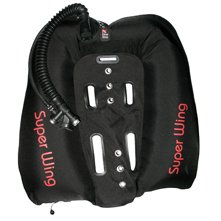|
Buoyancy CompensatorsBuoyancy Compensators are one of the most important pieces of scuba diving equipment (second to the scuba regulator). BCs range in lift from 15 lbs. to well over 125 lbs. Scuba diving BCDs over 50 lbs. tend to more useful within the technical diving community, but I am starting to see more and more newer divers sporting this type of BCD on the dive boats or even at the local beaches. These newer divers or newbie divers, seem over whelmed by the size of these 50 plus lbs. (lift) compensators.
With the technical BCDs out of the picture, new divers tend to be buying more and more lift in their BCDs. The main reason for these purchases falls mainly with the local dive stores pushing the lift of a BCD as one of the key features. While lift is an important feature, it is not the main feature to make a buying decision on.
Eliminating the Horse Collar style from consideration (see our Vintage dive gear page for more information), there are two main types of buoyancy compensators, the jacket style and the rear inflation style.
Jacket style Buoyancy CompensatorsThese BCs are worn around the cylinder or tank and wrap around the waist. There is a shoulder strap on each side this will aid in keeping the BCD positioned underwater and allow load carrying support for those long walks from you car to the dive site. These wrap around BCs make it easier to maintain neutral buoyancy under water and while at the surface. Jacket-style BC's like the AquaLung Buoyancy Compensators, typically provide up to 30 lbs. of buoyancy (depending on size) and usually very comfortable to wear. These scuba diving BCDs are the most common among training and rental department. The newer styles also have the option for integrated weights to be carried. The integrated weight model is the most popular among newer divers. Expect to add $100 dollars for this option. There are some recreation/technical versions that enable a scuba diver to carry multiple tanks. Most real technical divers have a separate BCD for technical dives.
Back inflation or rear inflation models
Without a doubt all of the heavy lift BCDs is the back inflation models. One of the greatest advantages of the rear inflation BCD is the freedom of movement towards the front of the diver. Additional as the Buoyancy compensator is inflated, there is not any constriction around the mid torso of the diver. This bring up probably the most talked about disadvantage of the rear inflation BCD, it has the capability to push the diver forward, if it over inflated while at the surface. Most new divers will over inflate any BCD while at the surface, but will 50 lbs. of lift is can be a problem for new divers. I usually just instruct the diver, not to over inflate. Once you head is out of the water, let go of the inflation button. Check out our backplate and wing BCD setups at technical BCDs.
|
